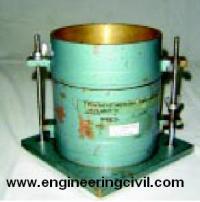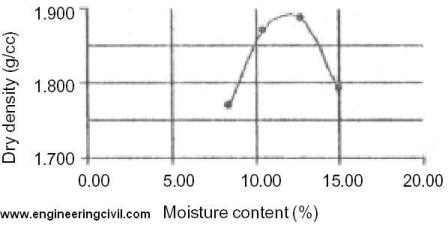This test is done to determine the maximum dry density and the optimum moisture content of soil using heavy compaction as per IS: 2720 (Part 8 ) – 1983.The apparatus used is
i) Cylindrical metal mould – it should be either of 100mm dia. and 1000cc volume or 150mm dia. and 2250cc volume and should conform to IS: 10074 – 1982.
ii) Balances – one of 10kg capacity, sensitive to 1g and the other of 200g capacity, sensitive to 0.01g
iii) Oven – thermostatically controlled with an interior of noncorroding material to maintain temperature between 105 and 110oC
iv) Steel straightedge – 30cm long
v) IS Sieves of sizes – 4.75mm, 19mm and 37.5mm

PREPARATION OF SAMPLE
A representative portion of air-dried soil material, large enough to provide about 6kg of material passing through a 19mm IS Sieve (for soils not susceptible to crushing during compaction) or about 15kg of material passing through a 19mm IS Sieve (for soils susceptible to crushing during compaction), should be taken. This portion should be sieved through a 19mm IS Sieve and the coarse fraction rejected after its proportion of the total sample has been recorded. Aggregations of particles should be broken down so that if the sample was sieved through a 4.75mm IS Sieve, only separated individual particles would be retained.
Procedure To Determine The Maximum Dry Density And The Optimum Moisture Content Of Soil
A) Soil not susceptible to crushing during compaction –
i) A 5kg sample of air-dried soil passing through the 19mm IS Sieve should be taken. The sample should be mixed thoroughly with a suitable amount of water depending on the soil type (for sandy and gravelly soil – 3 to 5% and for cohesive soil – 12 to 16% below the plastic limit). The soil sample should be stored in a sealed container for a minimum period of 16hrs.
ii) The mould of 1000cc capacity with base plate attached, should be weighed to the nearest 1g (W1 ). The mould should be placed on a solid base, such as a concrete floor or plinth and the moist soil should be compacted into the mould, with the extension attached, in five layers of approximately equal mass, each layer being given 25 blows from the 4.9kg rammer dropped from a height of 450mm above the soil. The blows should be distributed uniformly over the surface of each layer. The amount of soil used should be sufficient to fill the mould, leaving not more than about 6mm to be struck off when the extension is removed. The extension should be removed and the compacted soil should be levelled off carefully to the top of the mould by means of the straight edge. The mould and soil should then be weighed to the nearest gram (W2).
iii) The compacted soil specimen should be removed from the mould and placed onto the mixing tray. The water content (w) of a representative sample of the specimen should be determined.
iv) The remaining soil specimen should be broken up, rubbed through 19mm IS Sieve and then mixed with the remaining original sample. Suitable increments of water should be added successively and mixed into the sample, and the above operations i.e. ii) to iv) should be repeated for each increment of water added. The total number of determinations made should be at least five and the moisture contents should be such that the optimum moisture content at which the maximum dry density occurs,
lies within that range.
B) Soil susceptible to crushing during compaction –
Five or more 2.5kg samples of air-dried soil passing through the 19mm IS Sieve, should be taken. The samples should each be mixed thoroughly with different amounts of water and stored in a sealed container as mentioned in Part A)
C) Compaction in large size mould –
For compacting soil containing coarse material upto 37.5mm size, the 2250cc mould should be used. A sample weighing about 30kg and passing through the 37.5mm IS Sieve is used for the test. Soil is compacted in five layers, each layer being given 55 blows of the 4.9kg rammer. The rest of the procedure is same as above.
REPORTING OF RESULTS
Bulk density Y(gamma) in g/cc of each compacted specimen should be
calculated from the equation,
Y(gamma) = (W2-W1)/ V
where, V = volume in cc of the mould.
The dry density Yd in g/cc
Yd = 100Y/(100+w)
The dry densities, Yd obtained in a series of determinations should be plotted against the corresponding moisture contents,w. A smooth curve should be drawn through the resulting points and the position of the maximum on the curve should be determined. A sample graph is shown below:

The dry density in g/cc corresponding to the maximum point on the moisture content/dry density curve should be reported as the maximum dry density to the nearest 0.01. The percentage moisture content corresponding to the maximum dry density on the moisture content/dry density curve should be reported as the optimum moisture content and quoted to the nearest 0.2 for values below 5 percent, to the nearest 0.5 for values from 5 to 10 percent and to the nearest whole number for values exceeding 10 percent.
If you have a query, you can ask a question here.



is it possible to have soil with many mdd
no , if you accurately you will get one mdd only
Depending on soil properties, ther is chance of different MDD
its great to have a site were young engineers like me can share our views, and also ask questions. Thanks to the author of this site. Remain blessed and always update the site please. You have being a blessing to me and all civil engineers around the globe. k
What is the significance of light compaction test
Would you please show me how to caculate the theoritical dry unit weight equation for the total material composed of fine and oversize fractions (ASTM 4718)
Min & Max Teperature of pouring in concrete
There isn’t necessarily a min/max temperature for pouring concrete. You don’t want to pour on frozen subgrade and the lowest temp that I’d consider is probably 20 degress F. In order to avoid shrinkage cracks and flash setting of the concrete, you need to consider a combination of relative humidity, wind speed, and temperature. If there is 10% humidity with a 30 mph wind, the max temperature will be much lower than if you have 40% humidity with no wind.
That being said, if you’re talking about the temperature of the concrete then I recommend the minimum temperature be 60 degress and the max be 90 F.
what is the difference b/w mdd and bulk density?
How OMC is effecting to strength of compacted area ?
useful for me
It’s really useful for me
Waooo, dis site iz awesome. Tnx to the creators. Am jst getting what am expectin.
it is really useful for me & thanks the author of this web site
how do you come up with a California bearing ratio?
What is you the plot the moisure content verses dry density to calculate maximum dry density and optimum moisture content and the curve is inverved or “U” shaped?
Learning is easy through this site.
what is the difference when mdd/mc curve prepare with different compaction efforts (standard & modified)?
how the dry density increases on increasing the moisture content that may be upto certain limit but wat is the logic behind this?
Dry denisty increases with increase of moisture content up to filling of air voids between sand particles ,when
voids are filled the density will reduce
yes mdd is proportional to the compaction effort
good site for all civil engineers
What is the proper MDD,Grading (i.e % passing sieve 0.075microns) P.I, and L.L for formation level.
list the maximum dry density & Optimum moisture content values for different type of soils